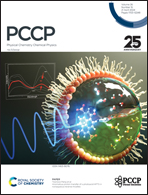Proposals for gas-detection improvement of the FeMPc monolayer towards ethylene and formaldehyde by using bimetallic synergy†
Abstract
Development and fabrication of a novel gas sensor with superb performance are crucial for enabling real-time monitoring of ethylene (C2H4) and formaldehyde (H2CO) emissions from industrial manufacture. Herein, first-principles calculations and AIMD simulations were carried out to investigate the effect of the Fe–M dimer on the adsorption of C2H4 and H2CO on metal dimer phthalocyanine (FeMPc, M = Ti–Zn) monolayers, and the electronic structures and sensing properties of the above adsorption systems were systematically discussed. The results show that the FeMPc (M = Ti, V, Cr, Mn) monolayers interact with C2H4 and H2CO by chemisorption except for the FeMnPc/H2CO system, while the other adsorption systems are all characterized by physisorption. Interestingly, the adsorption strength of C2H4 and H2CO can be effectively regulated by the bimetallic synergy of the Fe–M dimer. Moreover, the FeCrPc and FeMnPc monolayers exhibit excellent sensitivity towards C2H4 and H2CO, and have short recovery time (4.69 ms–2.31 s) for these gases at room temperature due to the effective surface diffusion at 300 K. Consequently, the FeCrPc and FeMnPc materials can be utilized as high-performance, reusable gas sensors for detecting C2H4 and H2CO, and have promising applications in monitoring the release of ethylene and formaldehyde from industrial processes.



 Please wait while we load your content...
Please wait while we load your content...